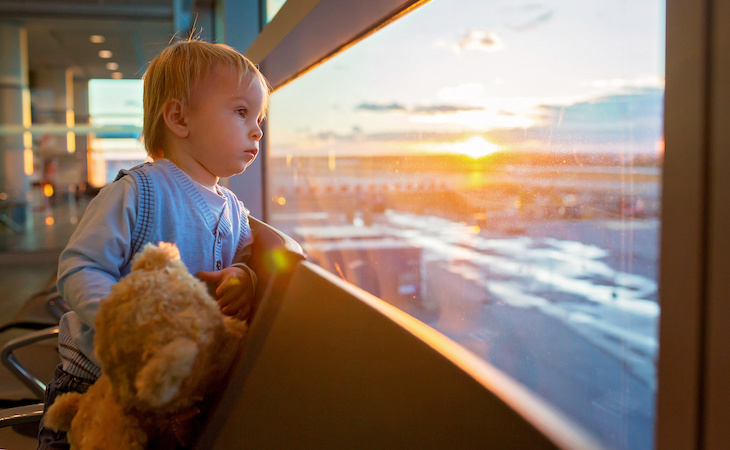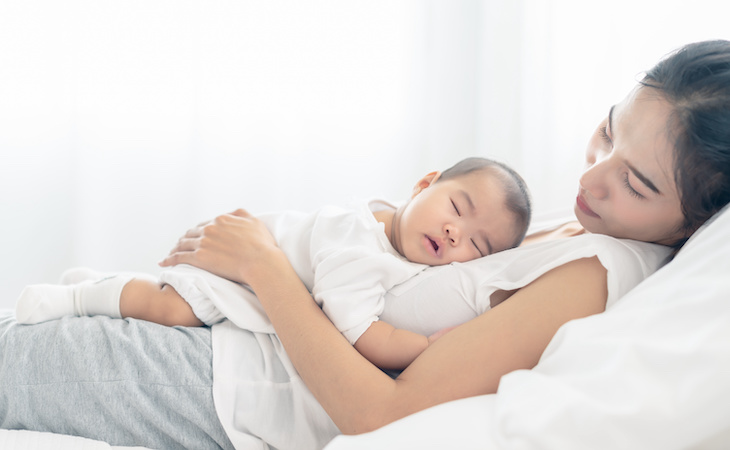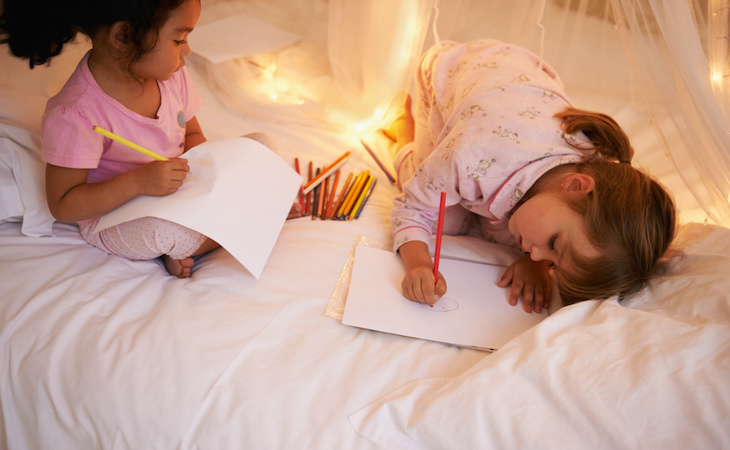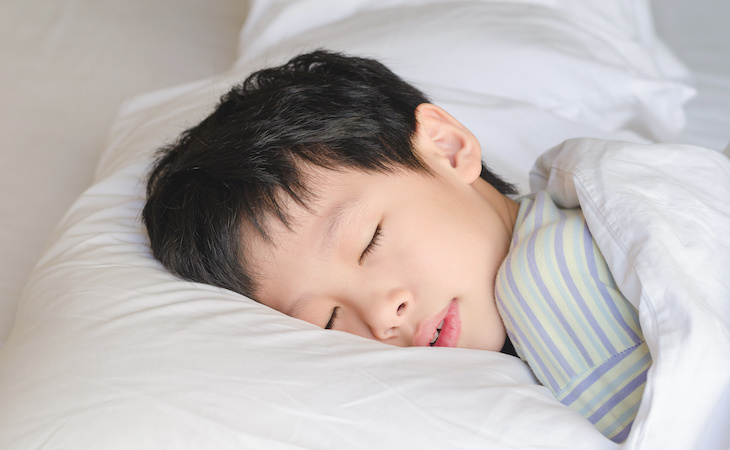Traveling with a baby is a rite of passage of new parenthood. There are countless ways to prepare (or stress), but ultimately, you do it—and you learn as you go, every trip giving you more and more insight as to what works for you and your family and how to navigate everything from naps on the go to new beds and more.
Sleep is paramount for everyone, especially infants and toddlers who need lots of it (including sleep peppered throughout the day). So giving some foresight as to what sleep will look like when away from home (How will you handle changing time zones? Where will kids sleep?) can pay off in dividends.
Of course, parents who travel frequently master the art of flexibility; they know that the only plan is that things won’t go according to plan. But here are some—albeit loose—ways to prepare for baby and toddler sleep during trips.
Baby sleep and travel tips that work
If you can, book the morning flight
“Kids are up early anyway,” says Imani Payne, a mom of two who travels frequently with her children and documents her motherhood via the Instagram platform @realgrowingpaynes—so why not lean into those hours?
You can time a baby’s first time around a trip to the airport or the flight itself, as Payne does, since “planes are basically giant sound machines.”
A somewhat unrelated yet noteworthy perk for early bird flyers: Morning flights tend to have fewer delays. The air is less crowded, and planes from the day before have already landed. Being one of the first flyers can set you up for a smoother day—from sunup to sundown.
Think about nap spaces
Love to babywear? Don’t go anywhere without your stroller? Have an older child who needs their own space? Try to replicate these types of environments on travel days.
For Payne, this means using soft baby wraps without buckles and hooks—a comfy option for long days of travel and naps. “You can put the wrap on at home and wear it through security and onto the plane, allowing you to pop baby in and out and be hands-free as needed,” she explains.
If you’re more into wheeling your children, then double-check your stroller; some aren’t airplane-friendly.
Parents sing the praises of the Doona for infants, which doubles as a car seat and is narrow enough to fit down an airplane aisle while being pushed; the Mountain Buggy nano, which is small enough to fit in an overhead compartment folded (and big enough for bigger kids too); and the Bugaboo Butterfly seat stroller, which is the brand’s lightest weight stroller at 16 pounds with plenty of under seat basket space.
Payne says she splurged on Stokke’s JetKids Bedbox. “I absolutely love it,” she says. “It makes airplanes much more comfortable for toddlers and young children. It fits under the seat in front of your child, and when they get tired, you can flip the top over, and it creates a flat surface for toddlers to lay down to nap on the plane.”
Ease up on your routine
Talk to parents who travel a lot, and they’ll tell you that trying to control too much or expect routine perfection on a travel day is unrealistic—and a recipe for disaster.
Instead, accept that any nap is a good nap, bedtime will likely look different, and things will be a bit off for a travel day; that’s normal. Embracing a flexible mindset allows you to adjust and adapt as needed—and enjoy the moment more.
…accept that any nap is a good nap, bedtime will likely look different, and things will be a bit off for a travel day; that’s normal. Embracing a flexible mindset allows you to adjust and adapt as needed—and enjoy the moment more.
Rest assured: Airports are required to be lactation-friendly
For babies, it’s eat, sleep, repeat. While breastfeeding or bottle feeding on the go can be overwhelming, the Friendly Airports for Mothers (FAM) Act requires that all large, medium, and small airports provide private dedicated space (read: not a bathroom) in each terminal building for lactation. These might be private rooms or pods by companies like Mamava, which have spaces at airports around the country.
As a reminder, breastfeeding in public is also legal in all 50 states, so while you can seek out a private area to pump or nurse, you don’t need to. And bottle feeding or breastfeeding an infant during takeoff or landing is a great way to soothe them—sometimes to sleep.
Per TSA regulations, breastmilk, formula, toddler drinks, and puree pouches are also allowed through security in quantities over 3.4 ounces.
Adjust to a new time zone
The general rule of thumb for landing in a new location is that adjusting for every hour you change will take you a day. (Headed from NYC to LA? Expect to feel “caught up” on day three.)
Of course, there are ways to help nature along. “After the first night, I try to get them on local time as quickly as possible,” says Payne.
The best ways to do this—and a good recipe for circadian rhythm, in general—is well-timed sunlight exposure (bright light in the a.m., dark spaces in the evening) and food (meals at appropriate times in your destination’s time zone).
Pack for a solid sleep
Favorite sleep products from parents vary. You’ll always want to pack loveies or other special things that help your kids sleep. On top of those…some of my favorite cribs include Graco’s Pack ‘N Play, BabyBjörn’s Travel Crib Light, and The Lotus Travel Crib by Guava Family. (If you’re staying at a hotel, ask if they provide cribs too—some do!).
Caregivers also love the Slumberpod, a portable blackout-shaded tent that many parents call a complete “game-changer” for sleep on the go. (If you’ve ever put a Pack ‘N Play in a hotel room bathroom for a makeshift baby or toddler bedroom, then you may want to consider investing in it.)
No Reception Club’s cult-favorite Hideaway Carry-on Duffel is also ideal for parents of littles (you’re allowed one bag per child) so you can pack all you need for sleep on the go, with pockets and places for all of the things. The company was founded by a mom/dad duo!
Finally, portable sound machines (Hatch’s new Rest Go has all the high-quality sounds of its bigger sister plug-in versions and 15 hours of battery life) are always a helper too.
FAQs
Does traveling affect babies’ sleep?
Yes, traveling can affect your baby’s sleep schedule. Long days of travel, disruption in feeding and napping routines, and sleeping outside of your regular environment can all impact a baby’s sleep.
How can I get my baby to sleep better while traveling?
There are a few things you can do to get your baby to sleep better while traveling. Consider booking a morning flight; think about spaces for napping while in the airport or on a plane; try to stay on a regular feeding schedule; do your best to adjust to a new time zone as quickly as possible; pack products that will help your baby sleep; and don’t expect perfection when it comes to a routine while on vacation.
Check out more helpful content for parents and families from Cassie Shortsleeve:
- 3 Common Questions About Sleep After Maternity Leave, Answered
- Your Fourth Trimester Sleep Survival Guide
- 7 Things No One Tells You About Postpartum Sleep
- 6 Common Questions About Room Sharing for Kids, Answered
- 7 Tips to Transition Your Child From Crib to Bed








